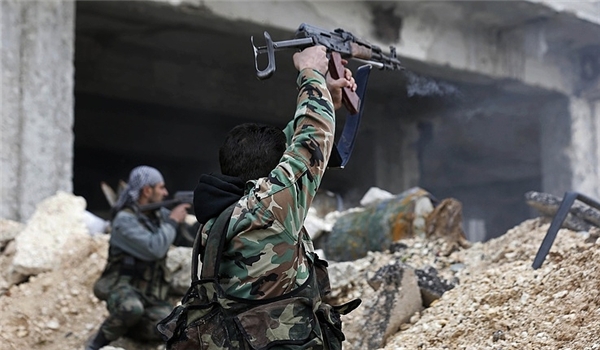Syrian Army Engages in Fierce Clashes with ISIL Near Homs’ T4 Airbase


“Tough battle is underway around T4 airbase and the ISIL is trying to seize the airbase in the Eastern part of Homs province,” the Arabic-language Qassiyoun news website affiliated to the Syrian dissidents reported.
Meantime, the Syrian army has launched artillery and missile attacks on the ISIL’s military positions.
The Russian fighter jets also launched aerial attacks on the surrounding areas of T4 airbase to block the ISIL’s advances towards the airbase.
T4 airbase is located 95 kilometers to the East of Homs and around 69 km to the West of Palmyra.
In November 2014, the ISIL terrorists had laid siege on T4 airbase but failed to capture it after the terrorist group seized al-Shaer and Jahar gas fields.
Earlier on Monday, several hundred more of Syrian Army soldiers arrived in areas near the ancient city of Palmyra (Tadmur) in Eastern Homs to join government forces’ imminent operation to take back the historic city from the ISIL terrorists.
According to the reports, the fresh forces and their comrades in the region are about to recapture the heights near Palmyra, and then target ISIL’s gatherings and movements inside Palmyra with the back up of the Russian warplanes and the army’s artillery units.
ISIL kicked off a large-scale operation with thousands of forces to take control of Palmyra that was liberated by the army men in March 2016.
The ISIL took control over some energy fields and strategic heights and approached Palmyra.
The terrorist group finally entered the city of Palmyra on Saturday night, but the Russian and Syrian forces could repel their attacks, killing hundreds of them. Yet, the terrorists could take the city on late on Sunday.
The Russian Defense Ministry announced on Sunday that Syrian Army soldiers with aerial support of Russian fighter jets killed over 300 terrorists.
“During the (Saturday) night, Syrian government forces, actively supported by the Russian Aerospace Forces, repelled all attacks by (ISIL) terrorists on (government positions in) Palmyra. The invading side actively used car bombs, armor and rocket artillery systems,” the ministry’s statement read.
According to Moscow, the Russian warplanes conducted 64 airstrikes on the militants’ positions and reserves, while eleven battle tanks and infantry fighting vehicles, 31 cars with heavy machineguns were destroyed, and over 300 militants were killed.
4,000 fighters of the ISIL carried out again a large-scale offensive against government positions in Palmyra from several flanks and finally managed to capture the city, while only 800 army soldiers were defending the city and there was no possibility for aerial coverage by the Russian and Syrian warplanes due to bad weather.
The Russia’s center for Syrian reconciliation noted ISIL had moved considerable forces from their stronghold of Raqqa, while more forces and equipment were relocated from Deir Ezzur.
The center cited intelligence data that ISIL had moved up to 5,000 fighters to the cities of Raqqa and Deir Ezzur from the Iraqi stronghold of Mosul.
Meanwhile, Homs Governor Talal Barazi announced that Syrian government forces managed to evacuate some 80 percent of Palmyra population, the fate of the rest is a cause for concern.
“Some 80 percent of Palmyra residents have been evacuated, we are concerned with the fate of those who are remaining there,” Barazi said in a statement on Sunday, adding that the Syrian army with allies is regrouping promptly, suggesting that control over Palmyra could be reestablished in the near future.
The Syrian Army, backed by the Syrian and Russian Aerospace Forces, liberated Palmyra in March, 2016, nearly a year after it was captured by ISIL in May 2015.
During the invasion, terrorists had cruelly destroyed a major portion of the historic sites in the city. UNESCO Chief Irina Bokova had warned that ISIL militants in both Iraq and Syria were responsible for “the most brutal and systematic” destruction of the ancient heritage since World War II.







